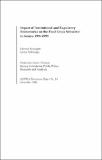| dc.description.abstract | This paper focuses on policy, institutional and regulatory reforms in the food
crops sub-sector: maize, wheat and rice. Reforms in this subsector were expected
to enhance market coordination and control, in addition to reducing exchange
and transaction costs at each stage of the commodity system. It was expected
that the reforms would stimulate growth in the sub-sector, which had deteriorated
due to government involvement. Although drastic increases in nominal producer
prices of maize, wheat and rice were recorded during the initial years of
liberalization, the expected supply response has not been realized. Indices of
input prices have had greater long-term rate of increase than those of output
prices resulting in decline in domestic food production. This has lead to increased
imports because consumption of the foodstuffs has been on the increase. The
poor performance of the cereals sector can also be explained by existence of a
poorly developed private sector whose growth has been stifled by high
transactional costs and lack of capacity to undertake agricultural activities; a
situation that has arisen out of slow institutional reforms and an unstable policy
environment governing imports and exports. While the general policy has been
to liberalize, the regulatory framework still supports controls, therefore
conflicting with the commercial mandate of the institutions supporting the food
crops. In some cases, as in the rice industry, the problem has been compounded
by lack of reforms in the tenure system under which rice is grown. For the full
benefits of reforms to be realized, there is need for rationalization of the policies,
with the government investing in areas that reduce transactional costs, and
creating a predictable policy environment for the private sector. Further,
institutional reforms should ensure that adequate capacity exists to implement
the policies. The regulatory framework needs to be harmonized with the policies
and this should, to a great extent, be a participatory process between the policy
makers and the farmers. | en |

